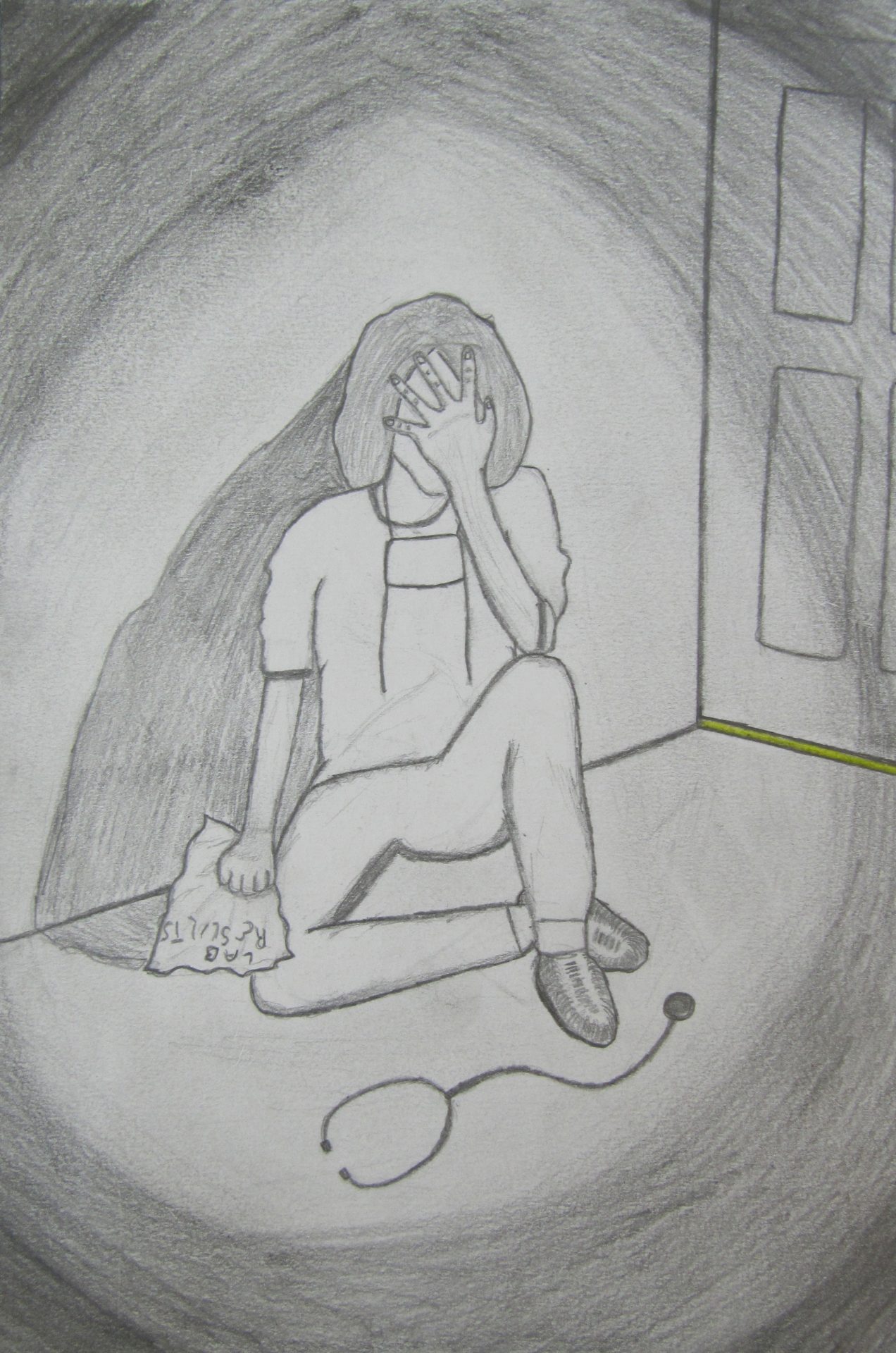Bad News
The drawing shows a doctor wearing scrubs and a surgical mask hanging on her neck, this signifies she is a surgeon. I chose to draw a surgeon because it is a speciality that I am personally interested in, and one I believe to be very rigorous and demanding. With such an intense workload, people can easily become overworked thereby accumulating stress which leads to burnout. The doctor is sitting on the floor, signifying physical exhaustion and a sense of defeat. Her crouched position depicts emotional resignation and an anxious/worried mental state.
I also chose to draw in black and white, using dark tones to further symbolise the emotional slump which makes her outlook on life very bleak. The lack of colour in the picture reflects her monotonous state and her feelings that there is no longer any excitement or fulfilment in the job. On the floor, in front of the doctor, her stethoscope lies abandoned by her feet. Normally, when we imagine the appearance of a doctor, they have their stethoscope around their neck or in their hands or pockets. In this drawing the stethoscope is on the floor symbolising a loss of motivation and enthusiasm for work.
I positioned the doctor in the centre of the page surrounded by darkness to illustrate a cold and lonely atmosphere. She has feeling of hopelessness at her current situation which precipitates her stress, and worsens her condition. The doctor has one of her hands totally covering her face so that her facial features cannot be seen. This symbolises depersonalisation. Our inability to identify her, mirrors her loss of inability to recognise herself. She feels like her current self is not the real her but a shadow of the person she knows herself to be; much like the large, looming shadow in the drawing. She cannot reconcile her current self with her self-identity of being strong, motivated and in control.
The doctor’s hand is just covering her face, it is holding her face while being supported by her knee which is propped up. This further emphasises her physical weariness but also signifies mental fatigue and exasperation. This will inevitably have adverse consequences on her work performance. Her second hand is balled up in a fist, crumpling up a piece of paper which reads lab results. The aim of this was to suggest that the results are unexpectedly undesirable, thereby illustrating a loss of effectiveness in her work performance. It could equally portray her frustration and anger at her current situation and feelings of powerlessness in improving patient outcomes. These negative feelings may be directed towards herself, as she blames her current physical, mental and emotional state of distress for any negative outcome in her patients.
The doctor is sitting behind a closed door. This signifies her denial of the true magnitude of her burnout and a desire to hide her moment of weakness from others rather than seek help. Doctors feel a great level of responsibility towards people and so may find it difficult to seek help from others when they are the ones who are normally sought for help, especially on health related matters.
In the midst of the dark and distressing situation which is seen in the drawing, there is a drop of colour. A small but bright ray of light can be seen through the crack under the door. This signifies that the solution to burnout lies on the other side of the door. In order to access it, the doctor must become fully self-aware of her current situation and be willing to seek help. The next step is to seek help to overcome her current situation. Only by opening the door and accessing her resources can she revert back to a desirable level of effectiveness.

I believe this piece really signifies how demanding, both mentally and physically, medicine as a career really is. The doctor is clearly showing sign of distress and is a low point in their career. This is why it’s so important to share you struggles and concerns with other colleagues or family and friends to share the burden with others and to not isolate yourself. The doctor pictured appears to be isolated which can makes any problems feel even worse. I really like this picture because it doesn’t paint over the difficulties of being a doctor which is important because it makes it more relatable as I’m sure every doctor has had a low period in their career. Doctors may find it difficult to seek help from others when ‘they are normally the ones who are normally sought for help’, so this drawing encourages them to seek help.
I think this piece depicts how isolating work as a medical student and doctor can be. It expresses the difficulties of a doctor to seek help with stress, anxiety and even suffering with a mental illness. It depicts the reality of doctors trying to cope on their own as they feel they are the ones who would normally help and treat others.
The piece seems to be depicting a Doctor at a particularly low point in her life. She is holding Lab results which may be the cause of her distress, though the biggest element of the work is that she is alone, I feel the piece emphasizes the point that we can all feel this way on occasion but also reminds you of the importance of seeking advice from friends and family before you reach such a desperate place.
This drawing is very striking, particularly for those working in a healthcare setting. It reminds the audience that doctors are people too and of the importance of looking after your mental wellbeing whilst doing such a stressful and demanding job. The dark shadows surrounding the doctor show how alone she feels and how the emotions are really starting to close in and could lead to a complete breakdown if they get much more intense.